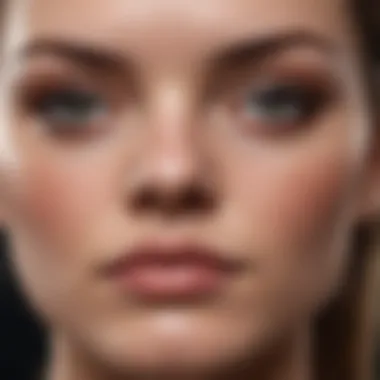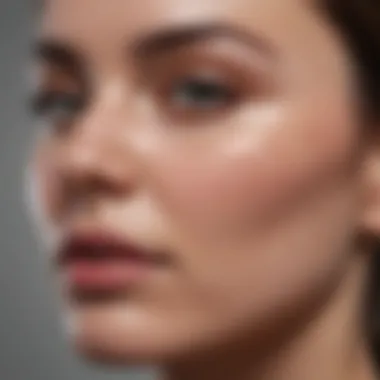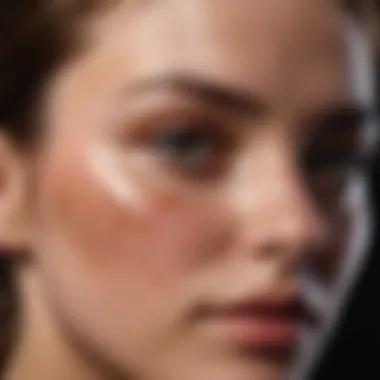Understanding Facial Skin Marks and Their Treatments


Intro
Navigating the landscape of facial skin marks can be daunting, yet understanding their nuances opens the door to effective management and enhanced self-confidence. Facial skin marks encompass a range of conditions, turning something as routine as looking in the mirror into a moment of contemplation. From freckles that are often seen as charming to moles or dark spots that may raise eyebrows, each mark carries its unique story. This guide aims to blend valuable insights with practical advice, ensuring you come away informed and ready to tackle any skin-related challenges that come your way.
Everyday life can often complicate our perceptions of beauty, particularly when skin marks are in play. It’s not just about aesthetics; it’s about understanding underlying causes, recognizing need for professional help, and identifying the right treatments. Herein lies a prominent intersection of value—the psychological impact of having visible markings on the face. Let’s delve deeper and unravel the layers of this intriguing subject, starting the journey toward clarity and empowered skincare.
Prelude to Skin Marks
Skin marks on the face can be more than mere aesthetic concerns; they often serve as windows into one's health and lifestyle. For many beauty enthusiasts and skincare aficionados, understanding these marks is pivotal. They not only inform us about our skin's history and genetics but also provide insight into the impacts of environmental factors, habits, and even emotional well-being. Addressing skin marks involves peeling back layers—much like our skincare routines—allowing aficionados to dive deep into effective management and prevention strategies.
Defining Skin Marks
When we talk about skin marks, we delve into a broad spectrum of nuances. Skin marks can encompass everything from freckles and age spots to moles, acne scars, and more. Each of these marks has its unique characteristics and implications, thus requiring distinct approaches for identification and treatment.
In more precise terms, skin marks refer to any noticeable alteration in skin color or texture. They can emerge due to various factors, ranging from sun exposure to hormonal changes and genetic predispositions.
Consider freckles, small, tan-colored spots usually brought on by sunlight. They tend to multiply during summer months owing to increased UV exposure. In contrast, age spots, often seen as brown or gray regions on those mature skins, signal long-term sun exposure. Each mark tells a story—a history of our interactions with the environment and our body's inherent processes.
Cultural Perspectives on Skin Marks
The perception of skin marks varies significantly across cultures and societies. In some cultures, marks like moles are seen as beauty spots or symbols of character, while in others, they might evoke negative imagery. For instance, youths in certain Western cultures may covet the sun-kissed freckles that signal youth and vitality. Meanwhile, societies deeply rooted in traditional beauty ideals may regard smooth, unblemished skin as the epitome of beauty, leading to a more critical stance toward any visible marks.
This dichotomy highlights how beauty standards are not static but evolve over time, informed by societal values, media representations, and individual experiences. It’s essential for beauty enthusiasts to acknowledge this cultural tapestry, as it shapes not only personal perceptions of skin marks but also how we address and manage them.
Types of Skin Marks
Understanding the various types of skin marks that can appear on the face is quite crucial not just in the academic sense, but also for practical day-to-day beauty regimens. Skin marks can be telltale signs of different biological processes or environmental factors at work. Knowing their characteristics empowers individuals to take better care of their skin and also helps in determining which marks might need professional attention.
Each type of skin mark carries its own significance, implications, and possible treatment paths. This section will uncover these details in the hope of enriching the reader's knowledge, ultimately affecting how they might choose to manage their skin health or aesthetic choices.
Freckles
Freckles are among the most charming of skin marks, often associated with youthful exuberance. These tiny spots, typically light brown, are the result of increased melanin production, especially after sun exposure. They are more prevalent in lighter skin types, wherein the skin's pigmentation reacts more readily to UV light.
People with freckles often view them as badges of beauty, though some may desire to diminish their appearance. A benefit of freckles is that they serve as a natural reminder to protect the skin from prolonged sun exposure.
Age Spots
Age spots, or liver spots, arise due to prolonged sun exposure and the natural aging process. They commonly appear as flat, brown, or black patches, particularly on areas frequently exposed to sunlight such as the face, hands, and shoulders. While harmless, they sometimes lead people to seek treatment for cosmetic reasons, especially when these spots make the skin appear older than it is.
Interestingly, age spots are more prevalent in individuals aged 40 and older, making them a visible marker of the skin’s history and resilience against sun damage.
Moles
Moles (or nevi) are skin marks made up of clusters of pigmented cells. They can be brown, black, tan, or even skin-colored, often appearing during childhood and adolescence. While most moles are benign, some can transition into malignant forms, such as melanoma.
It's crucial for individuals to perform regular skin checks to identify any changes in their moles, such as increased size or color variation. Consulting a dermatologist about unusual moles is advisable.
Acne Scars
Acne scars are a familiar sight for many, and their appearance is a reminder of past skin battles. They come in several forms: atrophic scars (depressed), hypertrophic scars (raised), and post-inflammatory hyperpigmentation, which leaves a dark spot after a pimple heals.


Scar management often requires various treatment options from topical solutions to advanced dermatological procedures. It's worth noting that addressing acne proactively can reduce the risk of scar formation in the first place.
Rosacea
Rosacea is a skin condition commonly manifested as facial redness, visible blood vessels, and sometimes acne-like bumps. While the exact cause remains unclear, it’s known to be exacerbated by factors such as sun exposure, stress, and certain foods.
Understanding rosacea is key for those afflicted, as the psychological impact of its appearance can be quite profound for many individuals. Treatment typically includes medications and lifestyle changes aimed at minimizing flare-ups.
Seborrheic Keratosis
Seborrheic keratosis refers to non-cancerous, wart-like growths that usually appear as brown, black, or tan patches on the skin. Although benign, they can be unappealing and lead individuals to seek removal. These marks are often hereditary and typically appear as people age. The fact that these growths might look alarming sometimes causes unnecessary concern for those unfamiliar with them.
Overall, understanding these types of skin marks not only aids in recognizing what is normal and what might need attention but also fosters a sense of agency over one’s skin health. Armed with this information, readers will be better equipped to make informed decisions about skincare and seek appropriate treatment when necessary.
Causes of Skin Marks
Understanding the causes of skin marks can shed light on their appearance and guide appropriate response and prevention strategies. Recognizing the origins of these marks not only aids in differentiation between benign spots and those that may warrant closer observation but also highlights the intersection of genetics, environment, and hormonal influences. This knowledge empowers individuals to make informed decisions about their skincare and health, potentially bolstering mental wellbeing in a society where physical appearance is impactful.
Genetics and Family History
Hereditary factors are surprisingly influential when it comes to skin marks. When one considers family medical histories, skin conditions often echo through generations like a common refrain. For instance, if a parent has a history of atypical moles, children may find themselves similarly predisposed. Not just limited to moles, this genetic predisposition can affect the likelihood of freckles, seborrheic keratosis, and other skin marks appearing over time.
Individuals should be vigilant if they notice familial patterns in skin marks, as some hereditary conditions could signal the need for medical scrutiny. Awareness of these patterns can be a helpful tool in managing personal skincare, encouraging proactiveness in monitoring skin changes.
Environmental Factors
UV Radiation
UV radiation is a primary player in the development of various skin marks. Its intensity fluctuates with geographic location and time of year. Thus, understanding one’s exposure level is vital. Consistent and unprotected exposure to UV rays can lead to pigmentation changes, which manifest as sunspots or even more serious conditions over the years. The key characteristic here is that UV light stimulates melanin production, sometimes excessively, leading to darker skin patches.
- High exposure can be detrimental: Over time, it contributes to premature aging and increases the risk of skin cancer.
- Can be counteracted: Strategies like using broad-spectrum sunscreen can significantly mitigate this damage.
"It's crucial to shield yourself from UV damage; a little prevention can save a lot in the long run."
Pollution
The impact of pollution on skin health is becoming more apparent. Airborne contaminants can penetrate the skin, leading to inflammation and a breakdown of collagen. This environmental factor can contribute to uneven skin tone and the formation of pigmentation marks as the skin tries to recover from daily assaults.
- Key feature of pollution: It encompasses various harmful substances, and understanding local pollution levels can highlight risks.
- Repercussions: Ongoing exposure may accelerate aging processes, affecting overall skin texture and appearance.
Skin Care Products
The products used on our skin can be a double-edged sword. On one hand, quality skincare routines can help maintain skin health; on the other, some products may trigger breakouts or irritation, leading to post-inflammatory hyperpigmentation. Ingredients like fragrances or alcohols may exacerbate skin sensitivity, resulting in unwanted, lasting marks.
- Selecting wisely is critical: Pay attention to labels and patch-test new products.
- Research-backed options: Rather than rushing to try the latest trend, delve into studies suggesting effective ingredients.
Hormonal Changes
Hormones have a profound influence over the skin’s behavior. Fluctuations during puberty, pregnancy, or menopause can exacerbate skin marks' visibility due to hormonal imbalances affecting melanin production. Women, in particular, may find themselves dealing with conditions like melasma, which is characterized by brown patches on the face that often appear during pregnancy or with the use of birth control.
Being aware of how these hormonal shifts affect skin appearance can promote a more forgiving perspective during these natural life phases. Such insights can significantly enhance one’s approach to personal skincare, fostering a sense of control and empowerment.
Identifying Skin Marks


Identifying skin marks accurately holds significant weight in our understanding of facial skin health. Not only do these marks tell a story about one’s dermatological history, but recognizing them is crucial for determining which require a simple treatment and which could signal a deeper medical concern. The concept of self-awareness towards one’s skin can lead to timely actions that prevent more severe issues down the line. In a world where first impressions often hinge on appearance, being informed about the nature of your skin marks contributes positively to personal confidence.
When to Seek Medical Advice
It's essential to know when to reach out for professional help regarding skin marks. Here are some red flags:
- Sudden changes in shape or color: If any mark begins to look different, especially if it changes rapidly, that could be a reason to consult a healthcare professional.
- Size Matters: Bumps or spots that grow beyond a pencil eraser recommend a clinical evaluation.
- Bleeding or Crusting: Marks that bleed, itch, or produce crust may indicate an underlying issue that needs examination.
- Family History: If there's a pattern of skin cancer or related issues in your family, regular check-ups become doubly important.
- Location: Marks that occur in areas of frequent sun exposure, like the face, can also require vigilant monitoring.
"An ounce of prevention is worth a pound of cure."
This saying rings true in skincare! Keeping an eye on these elements can lead to timely discovery, significantly improving treatment outcomes.
Self-Examination Techniques
Regular self-exams can be an effective shield against potential skin-related issues. Here’s how to conduct a thorough examination:
- Find a Well-lit Area: Natural light is the best. Stand in front of a mirror.
- Use Two Mirrors: Using one mirror at the front and another to view your profile helps spot marks that might be hidden.
- Consider Your Body: Assess your skin from head to toe. Pay special attention to areas that are easily missed, such as behind the ears, the scalp, and the back.
- Document Changes: Keep a log of any new marks or any changes in existing ones—photos can be particularly helpful.
- Be Thorough but Gentle: Use your fingers to explore different areas, identifying if the texture or elevation of the mark varies. Grains, bumps, or crusts can all give hints about what is going on beneath the surface.
By regularly employing these self-examination techniques, one cultivates a consistent habit of checking their skin. It equips beauty enthusiasts not just with knowledge but with the power to take control of their skincare health.
The Psychological Impact of Skin Marks
The presence of skin marks on the face can evoke a range of emotional responses, significantly impacting a person’s psychological well-being. This section delves into how these marks affect self-esteem and confidence, and also explores social perceptions and potential stigma that may arise from having visible skin conditions. As we navigate through societal standards of beauty, understanding the nuances of psychological implications becomes crucial for individuals, especially beauty enthusiasts and skincare lovers who wish to embrace their skin journey.
Self-Esteem and Confidence
For many, skin marks like freckles, acne scars, or age spots can create a tumultuous relationship with self-image. Self-esteem is inherently linked to how individuals perceive their physical appearance. To put it plainly, a person who feels uncomfortable or less attractive due to skin marks may experience lower confidence. Here’s how skin marks can affect self-esteem:
- Comparison and Society: Many people compare themselves to idealized images often propagated through media. When someone sees blemish-free skin as the standard of beauty, it’s natural to feel disheartened if their own skin doesn’t match that ideal.
- Self-Care Practices: For some, these conditions can lead to an obsession with skincare routines and products, sometimes to the detriment of mental health. Overemphasizing the need for perfection can spiral into anxiety or depression, especially if results are unsatisfactory.
- Social Situations: Engaging in social activities can become daunting. An individual might avoid gatherings for fear of judgment or comments. This withdrawal can contribute to feelings of isolation, further impacting overall well-being.
It's essential to understand that skin marks are common and, in many cases, completely natural. Recognizing this can create a foundation for rebuilding one’s self-esteem. Therapies, whether professional counseling or peer support groups, can play an instrumental role in helping individuals navigate these emotions.
Social Perceptions and Stigma
Skin marks not only affect personal feelings but also influence how individuals are perceived socially. Stigma surrounding visible skin conditions can stem from deep-rooted beliefs about beauty and acceptability. Here are some aspects of this phenomenon:
- Judgment and Stereotypes: People might wrongly associate skin marks with poor hygiene or careless living, fostering an unfair stigma. This could lead to interactions that prioritize surface appearances instead of one's character or qualities.
- Cultural Context: In some cultures, specific skin marks are celebrated and signify beauty, while in others, they can be viewed negatively. For instance, in certain societies, facial scars might hold traditional value, whereas in others, they might lead to ostracism or bias.
- Media Influence: The portrayal of perfect skin in advertising and entertainment shapes societal standards, leading many to internalize the notion that skin marks indicate flaws rather than a reflection of individual stories and experiences.
"Beauty is not in the face; beauty is a light in the heart." – Khalil Gibran
This perspective serves as a reminder that self-worth should not hinge on skin appearance. Acknowledging the underlying biases can help individuals foster resilience against external pressures and societal expectations.
Treatment Options for Skin Marks
When it comes to addressing skin marks that may appear on the face, understanding the various treatment options available is crucial. This section will break down different types of treatments, their specific elements, and how they can contribute to achieving clearer skin. Each option has its benefits and considerations, empowering individuals to make informed decisions about their skincare.
Topical Treatments
Hydroquinone
Hydroquinone is a skin-lightening agent that works by decreasing the formation of melanin in the skin. It's commonly used to treat hyperpigmentation associated with various skin marks such as age spots and melasma. One of its key characteristics is that it can lead to significant lightening effects when used consistently. This makes Hydroquinone a popular choice in the world of skincare, especially for those dealing with stubborn dark spots.
However, it's vital to consider that Hydroquinone is a potent chemical. Being able to get fast results has its appeal, but it can result in side effects like skin irritation or even ochronosis (a bluish-black discoloration) with prolonged use. Therefore, it is advisable to limit its usage under the guidance of a skincare professional.
Retinoids


Retinoids, derived from Vitamin A, are well-regarded for their ability to promote skin cell turnover and boost collagen production. This quality seeks to reduce the appearance of fine lines while also aiding in the fading of certain skin marks. As a result, Retinoids are often selected for their dual action, tackling not only existing spots but also preventing new ones from surfacing.
The unique feature of Retinoids lies in their versatility. They come in various forms, including over-the-counter options and prescription variants, catering to different skin types and concerns. However, their potency often comes with the downside of potential irritation during initial use. Thus, starting with lower concentrations and gradually increasing can mitigate discomfort while providing desired results.
Natural Remedies
Natural remedies have gained traction as a gentler alternative to medical treatments for skin marks. Ingredients like aloe vera, vitamin C, and licorice extract are noted for their skin-brightening properties. These options are appealing due to their perceived safety and low risk of chemical side effects.
The key characteristic of using natural remedies is the nurturing aspect they provide to the skin. Unlike some synthetic agents, they often come with additional benefits such as hydration and anti-inflammatory properties. However, the caveat is that while they may help, results tend to be less pronounced when compared to stronger chemical treatments. Patience is essential, as it can take longer to see improvements.
Professional Treatments
Laser Therapy
Laser therapy offers an advanced treatment method that utilizes focused light to reduce or eliminate skin marks. It targets pigmentation and can resurface the skin, encouraging new, healthy skin cells to emerge. One of its defining features is precision; various laser types can be tailored specifically to different skin concerns. For example, fractional lasers work well on acne scars, while intense pulsed light (IPL) can address larger areas of pigmentation.
This treatment option is widely favored for its effectiveness and minimal downtime. However, cost can be a factor, and patients might experience temporary side effects like redness or swelling post-treatment. A proper consultation with a dermatologist is essential to tailor the procedure to individual needs and ensure safety.
Chemical Peels
Chemical peels involve applying a solution to the skin that exfoliates dead skin cells and encourages regeneration. They vary in depth (superficial, medium, or deep) and can address skin issues from pigmentation to texture. The key characteristic of a chemical peel is its ability to leave behind a fresh layer of skin that looks rejuvenated.
This method is beneficial for those looking for visible results without surgical intervention. Nevertheless, it is essential to consider that deeper peels come with increased recovery time and potential irritation. Consulting with a qualified professional can help navigate the most suitable options based on one’s skin condition.
Cryotherapy
Cryotherapy involves using extreme cold to freeze and remove unwanted skin lesions or marks. This technique is especially effective for superficial lesions like age spots and some moles. The standout feature of cryotherapy is its speed; treatments typically take only a few minutes, yielding quick results and minimal recovery time.
While it’s generally well-tolerated, individuals may experience discomfort during the session and temporary swelling afterward. Although side effects are rare, it’s crucial to ensure this method aligns with the skin's health needs.
Surgical Options
Surgical options for skin marks are often considered when other methods prove ineffective for more pronounced or problematic marks, such as large moles or persistent lesions. Surgical removal is definitive, offering clear benefits but should be approached carefully, with considerations surrounding scarring and recovery time.
Careful consideration of each treatment's criteria and potential impact is vital. The journey through choosing the right option requires not only a comprehension of the treatments themselves but also a respectful recognition of what they entail for individual skin health.
Preventing Skin Marks
Preventing skin marks on the face is not just about appearance; it's essential for overall skin health and well-being. Taking proactive steps can greatly reduce the likelihood of blemishes, spots, and other imperfections that may emerge as time goes by. A focus on prevention allows individuals to maintain their natural complexion and ultimately enhances confidence. Through informed choices in everyday skincare and lifestyle habits, anyone can shield their skin from unwelcome marks.
Sun Protection Strategies
The sun can be a double-edged sword. While sunlight is vital for life, overexposure can wreak havoc on our skin. Sun protection is paramount; one of the key strategies involves the regular application of sunscreen with at least SPF 30. This protects against harmful UV rays that contribute to skin aging, freckles, age spots, and even skin cancer. Here are a few practical sun protection tips:
- Apply sunscreen daily, even on cloudy days. UV rays can penetrate through clouds.
- Don't forget to reapply every two hours or after sweating or swimming.
- Wear protective clothing and wide-brimmed hats when outdoors.
- Seek shade during peak sun hours, usually between 10 AM and 4 PM.
- Consider using sunscreen-rated makeup that provides added protection.
"An ounce of prevention is worth a pound of cure."
Implementing these strategies does not need to feel burdensome; instead, it can be seamlessly integrated into a daily routine, ensuring your skin is treated with the respect it requires. This simple layer of protection can prevent a host of skin issues from developing.
Daily Skincare Routine Recommendations
A daily skincare routine goes a long way in keeping skin marks at bay. A consistently followed regimen can bolster the skin's barrier and promote overall skin health. When crafting your routine, consider the following components:
- Cleansing: Start with a gentle cleanser that suits your skin type. This helps remove buildup that can lead to irritation or marks.
- Exfoliation: Incorporate exfoliation into your regimen a few times a week. This can be performed using chemical exfoliants like AHAs or BHAs — these dissolve dead skin cells, revealing a brighter complexion.
- Moisturizing: Keeping the skin hydrated is key. A good moisturizer helps to maintain your skin’s balance and can prevent dryness that often leads to skin issues.
- Targeted Treatments: Use serums or treatments specifically designed for skin issues you notice, such as pigmentation spots or scars. Ingredients like vitamin C or niacinamide can be very effective.
- Night Routine: Don't overlook the importance of a regime at night. This is when the skin repairs itself, making it prime time for restorative products.
Adjusting your skincare regimen over seasons or based on your skin's needs is also wise. Listen to your skin and respond with care and timely adjustments, ensuring you combat potential marks before they settle in.
By engaging in these preventive measures, beauty enthusiasts can maintain their skin’s integrity while fostering confidence that shines through.







